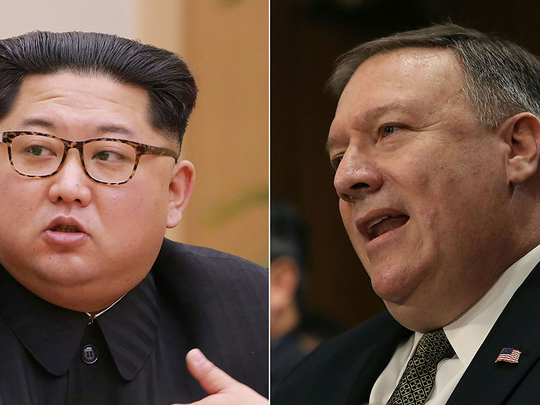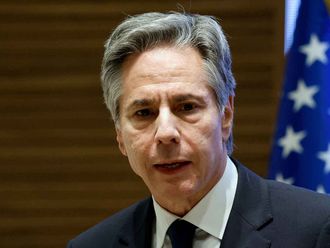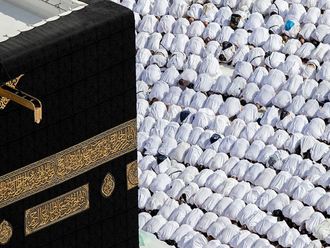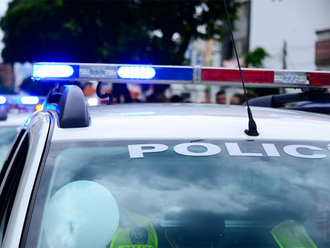
PALM BEACH, Florida: President Donald Trump’s decision to send his CIA director, Mike Pompeo, on a secret trip to meet North Korea’s leader, Kim Jong-un, reflects the president’s trust in and comfort with Pompeo, and how diplomats were sidelined in brokering what could be a landmark encounter between Trump and Kim.
Pompeo, nominated by Trump last month as secretary of state, played advance man for the president in Pyongyang, laying the groundwork for a planned meeting between the US and North Korean leaders that has been shrouded in mystery ever since the president unexpectedly agreed to it in early March.
“Meeting went very smoothly and a good relationship was formed,” Trump said in an early morning tweet before he went golfing with Japan’s visiting Prime Minister Shinzo Abe. “Details of Summit are being worked out now. Denuclearisation will be a great thing for World, but also for North Korea!”
Pompeo is still awaiting confirmation to his new post and faces a challenging vote in the Senate Foreign Relations Committee, where several Democrats have come out against him. The White House and Republicans seized on Pompeo’s trip as another reason for the Senate to confirm him, while Democrats said he had misled them by failing to disclose his mission, even in private conversations.
But the visit underscores the confidence that Trump has developed in Pompeo, a former Tea Party congressman who has emerged as one of the president’s closest advisers — a stark contrast to Rex Tillerson, whom Trump fired as secretary of state days after he accepted Kim’s invitation to meet.
It also underscores Trump’s unorthodox approach to one of the riskiest diplomatic gambits of his presidency. However trusted by the president, Pompeo is hardly a traditional emissary. He is not yet the nation’s chief diplomat but a lame duck as the nation’s spymaster.
Pompeo met with Kim on Easter Sunday, a senior official said, bringing along several aides from the CIA — but nobody from the State Department or the White House.
Some former administration officials expressed surprise that he returned from Pyongyang without any visible concessions, like the release of three Americans detained in North Korea. Pompeo raised the issue of the Americans, another official said, adding that the White House would continue to push for their release.
In 2014, the then-director of national intelligence, James R. Clapper, travelled secretly to North Korea to negotiate the release of two Americans, Kenneth Bae and Matthew Todd Miller. Three Korean-Americans — Kim Dong-chul, Kim Sang-duk, and Kim Hak-song — currently are being held on charges of espionage and committing hostile acts toward the North Korean state.
The administration also has not agreed on a date for the meeting of Trump and Kim, which officials said pointed to problems in settling on a site for the encounter. On Tuesday, Trump told reporters the White House was looking at five potential locations.
The White House has begun narrowing the list of options, a senior official said, eliminating sites like Pyongyang and the Demilitarised Zone between North and South Korea, which could pose an optics problem for Trump. Meeting somewhere in the United States remains a possibility, though that could raise similar problems for Kim.
The administration is studying several third countries — Singapore and Vietnam in Asia; Sweden and Switzerland, in Europe — though all are far from North Korea, posing a challenge to Kim’s fleet of rickety aircraft. Mongolia, which is closer to the North, is a long-shot, the official said.
Without a site, however, the White House has been unable to announce a date, though officials are sticking to Trump’s recent declaration that the meeting will be in late May or early June.
On Tuesday, Trump added to the mystery surrounding the visit by appearing to confirm that he had been in direct contact with Kim himself. He later clarified that while the talks were at “the highest levels,” he would “leave it a little bit short of that.”
Pompeo’s involvement with North Korea predated Trump’s decision to meet Kim, several officials said. He has been dealing with North Korean representatives through a channel that runs between the CIA and its North Korean counterpart, the Reconnaissance General Bureau.
He also has been in close touch with the director of South Korea’s National Intelligence Service, Suh Hoon, who US officials said brokered Kim’s invitation to Trump.
While a meeting of Trump and Kim would be one of the boldest diplomatic gambles of recent years, it was orchestrated largely by the intelligence services of the three countries.
Officials said Suh, the South Korean spy chief, laid the groundwork for Kim’s invitation in negotiations and a subsequent meeting in Pyongyang with Kim Yong Chol, a powerful general who heads inter-Korean relations and used to run North Korea’s intelligence service.
Suh was one of two South Korean envoys who visited the White House to brief Trump on their meeting with Kim Jong-un in Pyongyang — which led to the president’s impromptu decision to accept Kim’s invitation.
For Pompeo, who now has an office at the State Department, the choice to use the intelligence channel was mostly a convenience — allowing him to be involved in the planning while he awaited his move to the State Department.
Still, some officials expressed concern about the CIA’s taking the lead in orchestrating a leader-to-leader meeting — work that would normally fall to the State Department.
The intelligence officials on the North Korean side, they said, are shadowy figures, not least Kim Yong-chol himself, who is accused of masterminding the torpedo attack that sank a South Korean navy ship in 2010, killing 46 sailors.
The State Department’s role in North Korea dwindled after Trump publicly split with Tillerson over his efforts to open a diplomatic channel to the North, initially to obtain the release of the three Americans but also to set the stage for a broader negotiation.
In October, while Tillerson was in Beijing, Trump tweeted, “I told Rex Tillerson, our wonderful Secretary of State, that he is wasting his time trying to negotiate with Little Rocket Man ...”
Trump took up Pompeo’s cause, describing him before a lunch with Abe as “very smart but he gets along with people,” not least Kim. He predicted his nominee would clear the Senate, though he acknowledged the vote could be close.
Earlier, the White House recruited an ally, Senator Tom Cotton to tell reporters that Democrats who came out against Pompeo were “two-bit Tallyrands” and “munchkin Metternichs” — in other words, low-rent imitations of famous European statesmen.
Trump’s senior counsellor, Kellyanne Conway, said the decision to send Pompeo to Pyongyang showed the president already regarded him as “the nation’s chief diplomat.”












